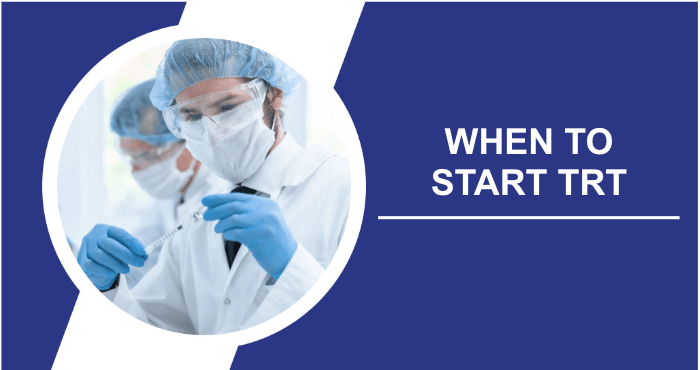Testosterone, the primary male hormone, plays a crucial role in our bodies, affecting various aspects such as muscles, bones, mood, and sexual desire, which extends to women as well. The challenge lies in the fact that our hormone levels naturally decline as we age, resulting in problems such as fatigue, decreased libido, and mood swings.
Fortunately, there is a solution known as Testosterone Replacement Therapy (TRT). The goal of TRT is to restore hormonal balance so that men can once again look and feel like their former selves, and sometimes even surpass them. Within this composition, we will delve into the essence of TRT, its mechanisms, and the expected results.
Most importantly, we will examine real-world results to provide you with a comprehensive understanding of how TRT can help. Whether you are curious about TRT or are considering it as a viable option, this guide will provide you with the insight you need to make an informed decision before embarking on your TRT journey.
TRT Before And After: What To Expect & Real Results Discover the transformative journey of Testosterone Replacement Therapy (TRT). Learn what to expect before starting TRT and see real-life results. Explore the benefits, potential side effects, and how TRT can improve the quality of life for those with low testosterone.
Gain insight into the physical and emotional changes that often accompany TRT, along with success stories from individuals who have experienced its positive effects. Whether you're considering TRT or just curious about its effects, this informative guide will provide you with valuable insights into the world of TRT.
What Are Hormones?
Hormones are vital messengers in our bodies, often referred to as chemical messengers, that play an indispensable role in regulating various physiological processes. These microscopic substances are secreted by specialized glands, such as the thyroid, adrenal, and pituitary glands, and circulate through our bloodstream, affecting nearly every aspect of our health.
Hormones are responsible for controlling our growth, metabolism, mood, and even reproductive functions. In essence, they serve as the body’s internal communication system, ensuring that all bodily functions are coordinated and balanced.
What Role Do They Play In Our Bodies?
Hormones serve as the orchestrators of our bodily functions, working quietly behind the scenes to maintain balance. They regulate processes such as metabolism, ensuring that we have the energy we need for daily activities, while also influencing our moods and emotions.
Hormones also play a key role in reproduction, controlling fertility and pregnancy. From the subtle changes of adolescence to the significant shifts of menopause, hormones are the conductors that guide our bodies through the various stages of life. Understanding their role is critical to maintaining overall health and wellness.
What Exactly Is Testosterone?
TRT, or Testosterone Replacement Therapy, is a method used to address testosterone-related problems. Testosterone, a hormone, is produced primarily in the male testes, with minor production occurring in the female ovaries and adrenal glands. It serves as a central hormone with multiple functions in the body.
In males, testosterone plays a key role in promoting the development of male secondary sexual characteristics during puberty, including the appearance of facial and body hair, deepening of the voice, and increased muscle development. It also influences sperm production and overall sexual function. Women have significantly lower levels of testosterone than men, but it remains an influential player.
It helps maintain bone density, muscle mass, sexual desire and overall well-being in women. As individuals age, their testosterone levels naturally decline. In some cases, individuals may experience testosterone insufficiency or reduced levels, resulting in a constellation of symptoms such as fatigue, decreased sexual appetite, erectile dysfunction, mood swings, and loss of muscle mass.
- Accurate testosterone measurement
- Appointment with a doctor
- Cream and injection options
- Price: $35 – $199
- Rating ⭐⭐⭐⭐⭐
What Is TRT?
TRT, short for Testosterone Replacement Therapy, is a medical intervention designed to address testosterone deficiency by introducing testosterone into the body from an external source. It involves the administration of supplemental testosterone by various means, including injections, patches, gels, or pellets. The primary goal of TRT is to restore testosterone levels to a normal range, thereby alleviating symptoms associated with low testosterone and improving overall quality of life.
How Does Testosterone Replacement Therapy (TRT) Work?
TRT supplements the body with artificial testosterone to counteract the natural decline associated with aging. The most common method of TRT involves the administration of testosterone injections, which deliver a specific dose of synthetic testosterone into muscle tissue. Typically, testosterone replacement therapy injections consist of a synthetic variant of testosterone, such as testosterone cypionate or enanthate.
These synthetic versions are structurally similar to the naturally occurring testosterone produced by the body. These injections are available in a variety of concentrations, and healthcare professionals determine the appropriate dosage based on an individual’s specific needs and hormone levels.
After testosterone is injected into muscle tissue, it gradually enters the bloodstream and becomes available for use by the body. This injected testosterone serves to restore testosterone levels in the body, thereby alleviating symptoms associated with low testosterone, including:
- Fatigue and decreased energy levels
- Decreased libido and sexual dysfunction
- Mood swings and irritability
- Decreased muscle mass and strength
- Difficulty concentrating and memory problems
- Changes in body composition resulting in increased body fat
Healthcare professionals can administer TRT injections in a clinical or medical setting, but most people choose to self-administer at home. The frequency of injections may vary depending on the type of testosterone used and an individual’s response to treatment. In general, injections are given at intervals of one to two weeks. As testosterone levels are restored to the normal range through testosterone replacement therapy, many individuals experience significant improvements in their symptoms.
Energy levels increase, fatigue decreases, and mood becomes more stable. Libido and sexual function often improve, leading to an overall improved sense of well-being. In addition, TRT can effectively reverse the loss of muscle mass and strength, facilitating participation in physical activities and producing remarkable before and after results.
While TRT is highly effective in addressing the symptoms of low testosterone, it is imperative to attend regular follow-up appointments and undergo blood tests to monitor hormone levels and ensure safety. Monitoring the progress of treatment allows healthcare professionals to make dosage adjustments as needed and manage any potential side effects.
How Long Does It Take For TRT To Show Results?
The timeframe for TRT to show its effects can vary from person to person. Some people may notice improvements in their symptoms relatively quickly, typically within a few weeks of starting TRT. These initial changes often include increased energy levels, improved mood, and increased libido. However, it’s important to recognize that the full benefits of TRT may take several months to fully manifest.
Research suggests that noticeable changes in body composition may occur between the 12th and 16th week of treatment. The rate of progress with testosterone replacement therapy depends on several factors, including an individual’s age, the severity of the testosterone deficiency, overall health, and the body’s response to treatment. Patience and consistency with TRT are of the utmost importance as the therapy attempts to gradually restore hormonal balance.
It is imperative to carefully follow the prescribed dosing schedule to ensure that no doses are missed. Regular follow-up appointments and periodic blood tests during the early months of TRT play a critical role in monitoring hormone levels and confirming that treatment is progressing as expected. Depending on individual response and potential side effects, the dosage or treatment plan may be adjusted accordingly.
When To Start TRT
TRT is intended for individuals who are experiencing symptoms due to low testosterone levels. Because testosterone levels decline with age, it can offer significant benefits to those over the age of fifty. However, age alone should not be the primary determinant for starting testosterone replacement therapy.
If you are experiencing symptoms, the next step is to undergo blood tests to verify the presence of low testosterone levels prior to starting TRT. Certain bodybuilders and athletes may consider testosterone replacement therapy to enhance muscle growth and performance, but this should only be done under the supervision of a medical professional.
By working with a TRT clinic, you can obtain a prescription for pharmaceutical grade testosterone, which is significantly more consistent and of higher quality than most clandestine sources of testosterone. However, TRT may not be appropriate for individuals with certain medical conditions such as prostate cancer, breast cancer, severe untreated sleep apnea, or untreated heart disease.
TRT Outcomes: Before And After
Whenever you start something new, it’s natural to have questions about what to expect. And what better way to gain insight into the effects of TRT than by examining real-life experiences? The following sections will answer any questions you may have about the benefits of TRT and provide insight into what to expect from your first injection and beyond, spanning the first 90 days.
What Happens After Your First Testosterone Injection?
After receiving your first testosterone injection, you may experience different effects. Initially, some people may experience a slight pinch or temporary discomfort at the injection site, which is a common and temporary sensation. In some cases, there may be an immediate boost in energy or mood due to the sudden increase in testosterone levels. However, the full spectrum of effects of testosterone injections usually takes some time to become apparent.
Depending on the type of testosterone administered, it can take anywhere from 40 minutes to seven days to reach peak concentrations. One Reddit user shared his experience after his first injection: “I felt more relaxed than I have ever felt in my life. The presence of T felt like the missing piece in my life”.
Another Reddit user mentioned, “I noticed improvements within 3 days. I used to be very tired and napped daily. I lost interest in hobbies I used to enjoy. But as soon as I started taking testosterone, I felt great again. Fatigue disappeared, no more naps, abundant energy, and a significant boost in mood.
What To Expect: First Week Of TRT
During the first week of testosterone replacement therapy (TRT), you may experience significant improvements in symptoms such as increased vitality, improved mood, and increased sexual desire. It is important to be patient during this time, as individual responses to treatment may vary. If you do not experience immediate changes in the first week, it does not mean that you will not see improvements.
After the first week, your TRT clinic will schedule follow-up appointments to monitor your progress, evaluate your response to therapy, and assess your hormone levels. This regular monitoring ensures that your TRT regimen is progressing as expected and allows for any necessary adjustments to the treatment plan.
One Reddit user shares his personal experience: “My testosterone levels were in the 100’s for an extended period of time. Within the first few weeks of starting TRT, it felt like I was waking up from a long slumber. It was as if my brain and body had been on autopilot for an extended period of time and suddenly I was in the driver’s seat. I felt rejuvenated, more primal, exuding confidence, and much more alert. I will never again allow myself to experience that profound feeling of lethargy.
Before And After TRT: A Comprehensive Guide To The First 90 Days
During the first 90 days of Testosterone Replacement Therapy (TRT), individuals can expect to experience remarkable changes and improvements in their overall well-being. During the first few weeks, most individuals will notice increased energy levels, decreased fatigue, and an overall increase in motivation and vitality.
This energy boost often translates into increased productivity and a more active lifestyle. In addition, mood swings or irritability may stabilize as hormonal imbalances and fluctuations begin to even out.
What To Expect In The First 30 Days
Around the one-month mark, some individuals may begin to notice improvements in their libido and sexual function. Increased sexual desire and improved sexual performance are common outcomes of TRT for those struggling with low testosterone related sexual concerns.
What To Expect In 30-60 Days
Around the second month, noticeable changes in body composition may become more apparent. Individuals often observe an increase in lean muscle mass and improved strength, coupled with a reduction in body fat. These physical changes can contribute to a more sculpted and defined appearance.
What To Expect Between 60 And 90 Days
As the third month approaches, the effects of Testosterone Replacement Therapy (TRT) on bone density may begin to manifest. Increased bone density is a key benefit of TRT, reducing the risk of osteoporosis and associated fractures. It’s important to remember that individual responses to TRT can vary, and not everyone will experience identical results within the first 90 days.
Some changes may be more gradual, while others may be more rapid. Follow-up appointments with routine blood tests are essential during this interval to monitor progress, make any necessary adjustments to the treatment regimen, and ensure overall well-being and safety. As the body adjusts to the treatment, individuals can look forward to further improvements in their physical and emotional well-being in the months beyond the initial 90-day period.
The First 90 Days: True TRT Before And After Results
Let’s listen to someone who has chronicled his experience during his first 90 days of testosterone replacement therapy. Danny Bossa shares his journey with us, explaining that one of the main benefits he experienced in his third month was a significant increase in strength. In fact, Bossa expresses his amazement when he was able to perform 12 biceps curls with 35-pound dumbbells and then progressed to 10 curls with 40-pound weights for example.
What You Should Know About TRT Results After 3 Months
After the initial 90 days of Testosterone Replacement Therapy (TRT), individuals can expect to see continued and evolving improvements in various facets of their physical and mental well-being. While the initial 90-day period can produce significant changes, the effects of TRT can extend into the long term with continued treatment.
Physiologically, individuals may observe further advances in body composition, including increased muscle mass and reduced body fat, especially when combined with regular exercise and proper dietary habits. Stability in mood and emotional well-being tends to last as TRT maintains hormonal balance, contributing to a more consistent and optimistic outlook on life.
Levels of energy and vitality often remain elevated, allowing individuals to maintain an active and satisfying lifestyle. The positive influence on libido and sexual function continues, enhancing intimate relationships. With consistent physical activity and healthy routines, the muscle and strength gains achieved in the first 90 days can be maintained and improved. A similar trend can be seen in the reduction of body fat.
Regular follow-up visits with a healthcare professional are essential to monitor progress, adjust the treatment regimen as needed, and ensure overall well-being and safety. As the body adjusts to testosterone replacement therapy, individuals can expect to experience sustained and improved physical, emotional, and sexual well-being, ultimately resulting in an enhanced quality of life beyond the initial 90 days.
- Accurate testosterone measurement
- Appointment with a doctor
- Cream and injection options
- Price: $35 – $199
- Rating ⭐⭐⭐⭐⭐
How To Get A Testosterone Prescription
The process of obtaining a prescription for testosterone therapy begins with seeking the advice of a health care professional. Start by making an appointment with either a primary care physician, an endocrinologist who specializes in hormone treatments, or a specialized TRT clinic. It is important to choose a reputable and experienced provider with a proven track record in administering TRT.
However, if the idea of visiting a doctor’s office for appointments seems overly inconvenient (we get it!), there is a more convenient approach at your disposal. Using an online TRT clinic eliminates much of the inconvenience associated with obtaining a testosterone prescription. You can have a consultation with a healthcare provider from the comfort of your own home, expediting the initiation of the process.
During the consultation, it is important to be open and honest about any symptoms you may be experiencing that could indicate low testosterone levels. The healthcare professional will perform a thorough evaluation, which typically includes a blood test to measure hormone levels. Based on the results of the evaluation, if it indicates low testosterone levels and symptoms that could benefit from TRT, the healthcare professional will discuss the available treatment modalities.
These treatments may include injections, patches, gels, or pellets. The choice of treatment depends on individual preferences and medical considerations. Once the most appropriate treatment plan has been determined, the doctor will prescribe TRT. Subsequent follow-up appointments and periodic blood tests will be scheduled to monitor hormone levels and any potential side effects.
If any problems arise, your doctor will make the necessary dosage adjustments. If you are ready to embark on this journey, I highly recommend working with Fountain TRT, one of the best online TRT clinics. They begin your TRT expedition by offering a free personalized TRT assessment. Following the assessment, a Fountain TRT Provider will review the results with you during a one-on-one video consultation.
During this consultation, the Provider will assess your symptoms and arrange for blood work to evaluate your testosterone levels. Once the blood work is complete, you and your provider will work together to develop an individualized treatment plan tailored to your specific needs.
Is TRT Safe?
Testosterone replacement therapy (TRT) can be safe and effective under the supervision of a qualified healthcare professional. Before starting TRT, a comprehensive evaluation is essential to determine its suitability for an individual. Properly administered, TRT can help relieve symptoms associated with low testosterone levels and improve overall well-being.
However, it’s important to be aware of potential side effects, which may include acne, fluid retention, mood swings, and changes in cholesterol levels. Regular follow-up appointments and periodic blood tests are critical during TRT to monitor hormone levels and overall health. Working closely with a hormone therapy clinic is essential to ensure both safety and effectiveness.
What Are The Possible Side Effects Of TRT?
While Testosterone Replacement Therapy (TRT) can offer many benefits to individuals with low testosterone levels, it’s important to be aware of potential side effects. Some common side effects include acne, mood swings, and changes in libido. It’s also possible to experience headaches, fluid retention, or breast enlargement.
However, it’s important to remember that not everyone will experience these side effects, and they can often be managed with proper medical supervision and adjustments to the treatment plan. Before starting TRT, it is important to consult with a healthcare provider to discuss the potential risks and benefits tailored to your specific needs and health profile.
Frequently Asked Questions
Will I feel any immediate effects after taking testosterone injections?
The effects of testosterone injections can vary from person to person. However, some people may notice changes, such as increased energy or mood changes, within a few weeks of the injection.
What is the appropriate dose of testosterone for women?
The appropriate amount of testosterone for women depends on several factors and requires monitoring by a healthcare professional. In general, it is significantly lower than the standard dosage given to men.
Can TRT help reduce belly fat?
Testosterone replacement therapy can affect body composition and potentially reduce total body fat, including abdominal fat, in certain individuals when used in conjunction with a proper diet and exercise program.
How long does it take to lose weight while taking testosterone?
The length of time it takes to lose weight while on testosterone varies depending on individual aspects such as dietary habits, exercise routine, metabolism and overall health. It is not solely dependent on TRT.
Do I have to stay on TRT indefinitely?
Not necessarily. TRT is often used to treat testosterone deficiency and occasionally hormonal imbalances, and the duration of TRT depends on the underlying condition and the individual’s response to treatment. However, TRT typically involves a long-term commitment.
Conclusion
In summary, starting testosterone replacement therapy can be a life-changing journey for individuals experiencing symptoms of low testosterone. In this article, we’ve looked at what to expect at various stages of TRT, from the first week to more than 90 days. As you begin TRT, be prepared for potential changes in energy levels, mood, libido, body composition, and overall well-being.
Remember to communicate openly with your healthcare provider, attend regular follow-up appointments (even if it’s virtual), and adhere to personalized treatment plans to ensure the best possible outcome. TRT can significantly improve physical, emotional, and sexual health, ultimately leading to a better quality of life. Now that you understand the potential benefits, you can make an informed decision and look forward to a brighter and more vibrant future.
Sources
- Testosterone replacement therapy: For whom, when and how? – DOI: 10.1016/j.metabol.2018.03.007 Read more
- Testosterone Replacement Therapy for Sexual Symptoms – DOI: 10.1016/j.sxmr.2018.11.005 Read more
- Testosterone replacement therapy – DOI: 10.1100/tsw.2004.60 Read more
- Hormone Therapy: Testosterone Replacement Therapy – PMID: 37603880 Read more
Dr. Michael Bonner, a clinical psychologist in Salisbury, MD, received his MD and Ph.D. from Columbia University in 1967. Dr. Bonner obtained his MD and Ph.D. from Columbia University in 1967. Since retiring from medicine, he has been writing and editing on topics ranging from healthcare policy to basic science.
In addition to his professional accomplishments, Dr. Bonner is a sought-after speaker at academic and industry conferences, where he shares insights from his extensive career in psychology and healthcare. His work bridges the gap between clinical practice and academic research, influencing a new generation of professionals and students.
Brittany Hernandez specializes in assessing supplements, health technologies, and applications. She continually enhances her skills as a health copywriter. With a Bachelor's degree in Translation and Communication and a background in linguistics, Brittany is skilled at converting complex research into accessible, high-quality content. She is highly regarded in the health industry for her keen eye for detail and ability to identify high-quality health and wellness products.




